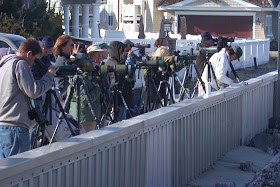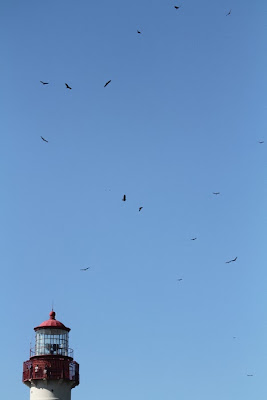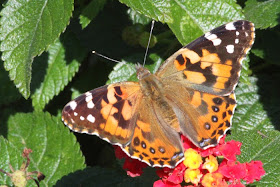October is the month that, for me at least, really signifies fall; with autumn colors now tinting the trees and temperatures dropping, certain sounds begin to resonate in my ears; White-throated Sparrows contacting each other with sharp, discordant
tseeps, from hedge bottoms; Golden-crowned Kinglets revealing their presence with a penetrating
see-see-see and the soft
tupp calls of Yellow-rumped Warblers just about everywhere you walk.
Coats, hats and scarves come out of their enforced aestivation, iced tea gives way to hot coffee and, before you know it, we're all gearing up for the main event of the year - CMBO's Autumn Birding Festival. As ever, this wonderful, annual celebration of birding in Cape May has a lot to offer - as demonstrated by the number of people who come back year after year; a chance to meet up with old friends, catch up on all the bird gossip and - of course - some great opportunities for being right on the spot while the pure exuberance of fall migration takes place all around.
But until we get there, we have the rest of October to fill all our birding desires so what to do over the next few days... Well, there's a catch, since Mother Nature has seen fit to mix up a whole swirly mess of clouds, wind and rain, which is bound to put a dint in the spirits of the most optimistic of birders. So, what does one do on a rainy day in Cape May? Here's some ideas...
1. Catch up on your birding notes. There's so much to see here that finding time to keep note of it all can be difficult. So, pick yourself a quiet corner in a favorite restaurant and get those notes up to date - there's a great range of places to go to do this and, though some of Cape May will be shutting down for the winter now, our friends at Bella Vida in West Cape May will be open. And if you really insist on keeping an eye on the birds while you do this, there's no better place than the Sunset Grille on Sunset Beach! Oh, and if you want to keep note-taking, the Northwood Center has waterproof notebooks to keep you happy!
2. Hook yourself up to the internet and get your notes permanently into your personal database. And don't forget, Cornell Lab of Ornithology would love you to share your sightings and have them be part of the ever-growing ground swell of information that is there to be tapped in eBird.
3. Visit the Northwood Center. This should be number one on the list really of course, for the Northwood Center has a multitude of things to keep you occupied while the rain trickles down the glass. How about buying a field guide to that destination that you know you have been promising yourself for next year? Buy a CD of bird calls and add an extra dimension to your birding or simply get your teeth into an infuriating jigsaw puzzle - we have some great ones to choose from. Then again, you could just swing by the Northwood Center and hang out; come and check out a new scope or binocular, catch up on the latest wildlife sightings with fellow enthusiasts or maybe, just maybe, you could be right on the spot when one of the pupating Monarchs spectacularly unfolds itself from its jade chrysalis and becomes a black and orange gem, ready to head south to Mexico.
4. OK, this is for those of you that really, really just can't stop birding. Head up to the Avalon Seawatch. No really!! It may seem like a crazy idea, and you will most certainly need your wet weather gear on, but the sort of weather that is heading our way can produce some wonderful flights of ducks, cormorants and all manner of other birds along the coast. No promises, of course; this is nature after all. But, well, you never know....
Recent Sightings
Just to catch you up with what's been happening this past few days, here's a few things that have come to my attention of late. Water levels at The Meadows are really low right now as the site is being prepared for some winter management, but the wet mud is still drawing in some good shorebirds. Both
American Golden Plover and
Baird's Sandpiper were reported today, while
Pectoral Sandpiper, Tricolored Heron and a good range of other birds have been present recently. The ponds at Cape May Point State Park are similarly short on water (though not for much longer!!) but Bunker Pond has a good range of ducks present, including the male
Eurasian Wigeon today.
Off Cape May Point,
Parasitic Jaegers continue to harass terns and gulls in the rips and scoters are starting to ferry in and out of the bay. A few
Northern Gannets are now present and Brown Pelicans are worth keeping an eye out for. Along the dune lines,
American Pipits, American Kestrels and
Merlins are passing overhead in good numbers and the dunes are filling up with
Palm Warblers and
Savannah Sparrows. Though October slowly creeps upon us, there are still a few warblers around; I managed 12 species of warbler on one street at Cape May Point yesterday, with at least two other species a couple of streets away. A
Clay-colored Sparrow was also a nice find on Alexander Avenue.
I spent a little time recently out on the barrier islands and was pleased to chance across a nice array of interesting birds. The barrier islands are quietening down as far as tourism is concerned now and any weather-blown stray bird has at least a modicum of opportunity to find what tiny patches of habitat remain there to rest and feed up. Small parties of
Black-crowned and
Yellow-crowned Night Herons can be found roosting in trees on less accessible patches of saltmarsh, while my own list of passerine species out there included both
Golden-crowned and
Ruby-crowned Kinglets, Brown Thrasher, Gray-cheeked Thrush, Common Yellowthroat, Northern Flicker and
Eastern Phoebe - all species that should be moving in good numbers now. The Northwood Center provided me with my first
Winter Wren of the season today, balls of
Cedar Waxwings moved through in blustery winds this morning and there was a very noticeable arrival of
Swamp Sparrows today.
Tomorrow is another day - don't get too cold or wet, if you can't face the weather, come and hang out with CMBO!!
Getting great shots of Virginia Rails is never easy and if you achieve it, it often comes at a cost. This bird had spent the last 36 hours or so looking rather forelorn at one of the dune cross-overs at Cape May Point. Meddling with nature is always a difficult judgement call, but in this case, it seemed to me that this bird had a better fighting chance if it was in something of a less public place and in habitat more befitting a rail. The fact that it could be picked up so easily was not encouraging, but it seemed strong and reasonably well fed so we released it along the edge of Lake Lily and wish it well over the coming days [photo by Mike Crewe].

Patsy, Lu Ann, Lousie and Samm - just four of the industrious Cape May Monarch team at the Pavilion Circle a few days ago (yes, sun, shadows and T-shirts!!). CMBO's Monarch Monitoring Project doesn't get anywhere near enough mentions on this blog, so here's an opportunity for you to catch up on this season's Monarch migration story and see how the project (and the Monarchs) are doing. Follow links by clicking here for the Monarch Monitoring Project blog, or clicking here for the project's main data page [photo by Mike Crewe].
And just to put it all into perspective for those of you not able to be here right now - this was the view from Stone Harbor, looking towards Wildwood on Monday evening. Doesn't it conjure up thoughts of Saraman and Lord Voldemort heading this way?! [Photo by Mike Crewe]



































